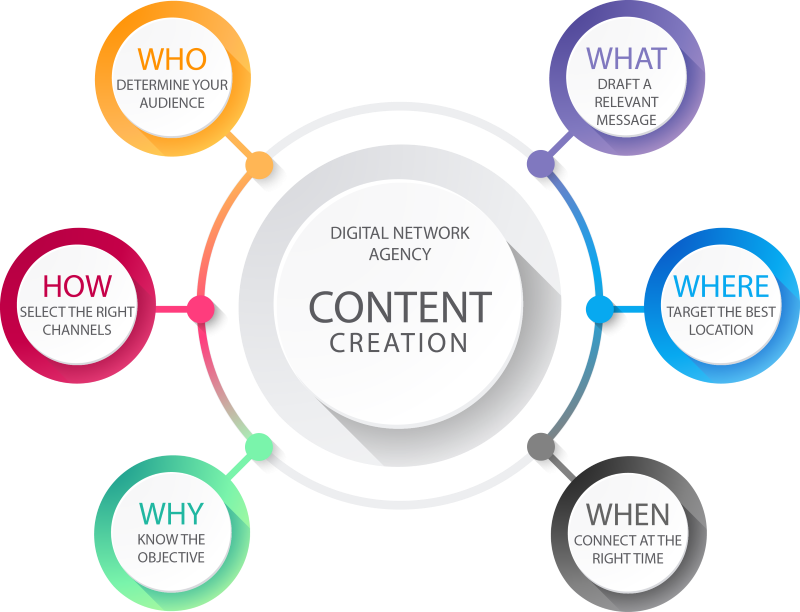Blog Here !
Dive into a world of knowledge and inspiration with our blog. Here, we share thought-provoking articles, industry trends, and expert insights on topics ranging from digital marketing and design to technology and business strategies. Discover valuable information that empowers you to stay informed, make informed decisions, and navigate the dynamic landscape of the digital realm

- All Posts
- Design
- SEO
- Uncategorized
- Web Development
- Website

Instagram Reels have evolved as a dynamic tool for businesses to display innovation, engage consumers, and drive success in the…

A visually appealing and current website is critical for leaving a lasting impression in the fast-paced world of the internet.…

User-generated content is a tremendous force in the digital realm, and user evaluations are no exception. User evaluations can have…

In the fast-paced world of digital marketing, content production is the lifeblood of success. Establishing an effective workflow is critical…

YouTube stands out as a powerhouse in the enormous field of online entertainment, but distinguishing out on YouTube requires more…

Facebook Shops have emerged as a great tool for businesses to exhibit and sell their products directly on the platform…

In today’s smartphone-dominated world, optimizing your website for mobile consumers is no longer an option; it’s a requirement. This article…

Every factor in the dynamic realm of marketing plays a critical role in shaping consumer behavior. Color is one such…

TikTok, the viral short-form video platform, is no longer limited to dancing youngsters. It has quickly turned into a potent…
Local search engine optimization (SEO) can help franchise businesses develop a strong online presence. This paper delves into practical tactics for improving local SEO, driving foot traffic to franchise locations, and establishing a uniform brand presence across many locations. Local SEO is critical for franchise success Understanding the importance of local SEO lays the groundwork for franchise success. Investigate how local SEO affects visibility in local search results, draws nearby customers, and encourages community engagement. Recognize the importance of local SEO in the development of trust and credibility for each franchise location. Conducting In-Depth Local Keyword Research Local keyword research is the cornerstone of effective local SEO. Investigate methods for locating location-specific keywords, such as city names, neighborhood references, and regional modifiers. Explore tools and techniques to understand local search intent and user behavior. Optimize your keyword strategy to align with the unique characteristics of each franchise location. Optimizing Google My Business (GMB) Listings Google My Business is an important component in franchising local SEO. Investigate GMB listing optimization tactics for each franchise location. Investigate the significance of correct business information, appealing descriptions, high-quality photos, and consistent categorization. Improve the visibility of your GMB listings in local map packs and search results. Developing Location-Based Landing Pages Each franchise location deserves its own website. Investigate methods for developing location-specific landing pages for your website. Consider including one-of-a-kind business information, local testimonials, and personalized material that resonates to the neighborhood. Optimize landing pages so that they are authoritative and relevant to local audiences. Using Local SEO Best Practices on Your Website Your website is extremely important in local SEO. Delve into on-page optimization strategies, including location-based meta tags, headers, and content. Explore the importance of clear NAP (Name, Address, Phone Number) information on every page. Optimize your website for a seamless user experience and search engine crawlability. Earning Positive Online Reviews for Each Location Online reviews play an important role in local SEO and reputation management. Investigate methods for encouraging customers to post favorable ratings for each franchise location. Investigate platforms such as Google, Yelp, and industry-specific review sites. Optimize your review generation activities to improve your online reputation and local search visibility. Building Local Citations and Business Directories Local SEO signals are strengthened by citations and business directories. Investigate methods for establishing consistent citations across web directories. Investigate industry directories, chambers of commerce, and regional business listings. Optimize your citation approach to guarantee that each franchise location has accurate and up-to-date information. Making Use of Local Structured Data Markup Structured data markup improves the information displayed in search engine results. Investigate methods for including local structured data markup on your website. Explore schema.org markup for business details, reviews, and location-specific information. Optimize your use of structured data to provide search engines with context about each franchise location. Tailoring Social Media Strategies for Local Audiences Social networking is an effective technique for increasing local engagement. Investigate techniques for personalizing social media material for each franchise location. Investigate geotargeted posts, community partnerships, and local events. Optimize your social media presence to represent each franchise’s distinct personality and engage with local audiences. Local SEO Performance Monitoring and Response Local SEO success requires consistent monitoring. Investigate key performance indicators (KPIs) such as local search ranking, website traffic, and online reviews. Investigate analytics tools and monitoring platforms to acquire performance information. Optimize based on data-driven analysis and respond to consumer feedback and inquiries as soon as possible. Dealing with Duplicate Content Issues Duplicate content might be detrimental to local SEO efforts. Delve into strategies for addressing duplicate content issues, especially for franchise businesses with similar offerings. Explore canonical tags, unique descriptions, and location-specific details. Optimize your content strategy to ensure search engines prioritize the most relevant and unique information. Managing Online Listings During Changes Changes to franchise firms, such as relocations or closures, are possible. Investigate methods for maintaining internet listings during such changes. Examine the significance of immediately updating GMB listings, citations, and website information. Optimize your approach to ensure correct online information and avoid customer confusion. Promoting Local Community Participation Community involvement is essential for local SEO for franchise businesses. Investigate methods for building relationships with local communities. Consider sponsorships, local event involvement, and cooperation with community organizations. Improve your community engagement activities to build a strong brand image and deepen bonds with each franchise site. Making Local Promotions and Incentives Available Local promotions increase foot traffic and local SEO visibility. Investigate methods for providing location-specific promotions, discounts, or incentives. Explore the use of online and offline channels to promote these offers. Optimize your promotional strategy to attract and retain local customers while boosting the visibility of your franchise locations. Staying Informed about Local Search Trends Local search patterns shift, influencing local SEO techniques. Examine the significance of remaining current on local search trends, algorithm updates, and consumer behavior. Look for information in industry magazines, search engine guidelines, and local SEO communities. Optimize your strategy to reflect current best practices and upcoming trends. Conclusion Local SEO is essential for franchise businesses seeking to dominate the local market. You can create a cohesive brand presence, increase foot traffic to each franchise location, and establish a strong and trusted local identity in the digital realm by following these techniques, which range from improving GMB listings to cultivating community involvement.
Effective Search Engine Optimization (SEO) is critical for visibility, traffic, and sales in the competitive landscape of online marketplace. This tutorial delves into the complexities of optimizing online marketplaces for search engines, offering techniques to boost discoverability and increase profitability. The Importance of SEO in Online Marketplaces Understanding the importance of SEO lays the groundwork for success. Investigate how SEO influences the visibility of products and categories in online marketplaces. Recognize the importance of search engines in linking potential buyers with the diverse range of offerings available in the competitive online marketplace ecosystem. Conducting In-Depth Keyword Research Keyword research is the foundation of good SEO. Investigate the process of determining appropriate keywords for your online marketplace. Explore tools and techniques for understanding user intent, analyzing competitor keywords, and selecting high-impact keywords that align with your product offerings. Optimizing Product Listings for Search Engines Individual product listings are important SEO touchpoints. Investigate methods for improving product titles, descriptions, and photos. Examine the relevance of creating distinctive and detailed text, including relevant keywords, and offering accurate product information. Improve search engine exposure by optimizing product listings. Creating Search Engine Friendly URLs and Navigation Search engine crawlers and user experience are influenced by URL structure and navigation. Investigate methods for developing SEO-friendly URLs that represent product categories and hierarchy. Investigate the significance of sensible navigation, which ensures that users and search engines can effortlessly traverse your online marketplace. Optimize for the delight of both users and crawlers. Product Schema Markup Implementation The use of schema markup improves the rich snippets that appear in search engine results. Delve into the implementation of schema markup for products in your online marketplace. Explore how structured data can provide additional information about your products, such as reviews, ratings, and pricing. Optimize for increased visibility and engagement. Encouraging User-Generated Content and Reviews User-generated material, such as reviews, is an effective SEO technique. Investigate ways for getting customers to post reviews and creating content. Examine how positive ratings affect search engine rankings and user trust. Optimize your online marketplace for genuine user experiences that aid in SEO success. Improved Mobile Responsiveness With the increased use of mobile devices, mobile responsiveness is critical for SEO. Investigate mobile-optimization tactics for your online marketplace. Investigate the concepts of responsive design, fast loading times, and user-friendly interfaces. Optimize for a smooth mobile experience that boosts search engine results. Creating Quality Backlinks Backlinks play an important role in search engine algorithms. Investigate methods for generating high-quality backlinks for your online marketplace. Explore partnerships, influencer collaborations, and content marketing to attract authoritative links. Optimize your backlink strategy to enhance the credibility and authority of your online marketplace. Utilizing Social Media for SEO Social media contributes to SEO by increasing brand visibility and traffic. Investigate tactics for promoting your online marketplace via social media channels. Investigate how social signals affect search engine rankings and user engagement. Improve your social media presence to support your SEO efforts. SEO Performance Monitoring and Analysis SEO success requires regular monitoring and analysis. Examine critical performance indicators such as organic traffic, keyword rankings, and conversion rates. Investigate analytics tools and platforms for tracking the SEO performance of your online marketplace. For continual improvement, optimize based on data-driven insights. Staying Current on Search Engine Algorithms Search engine algorithms change, which has an impact on SEO strategy. Examine the significance of being up to current on algorithm modifications. Explore industry publications, search engine guidelines, and forums for the latest insights. Optimize your online marketplace to align with current best practices and algorithmic preferences. Implementing Local SEO Strategies For online markets with physical presence, local SEO is critical. Investigate local SEO implementation tactics such as location-based keywords, Google My Business optimization, and local backlink creation. Investigate the influence of local SEO on getting clients in your area. Optimize for global as well as local search exposure. Dealing with Duplicate Content Issues Duplicate material can have a negative impact on SEO performance. Investigate strategies for dealing with duplicate content issues in your online marketplace. Investigate canonical tags, distinctive product descriptions, and efficient content management solutions. Optimize to guarantee that the most relevant and distinctive information is prioritized by search engines. Technical SEO Aspects Management For search engine crawlers, technical SEO considerations are crucial. Investigate techniques for controlling technical features such as XML sitemaps, robots.txt files, and website speed. Explore the impact of technical SEO on crawlability and indexing. Optimize your online marketplace’s technical infrastructure for enhanced search engine performance. Ensuring E-A-T (Expertise, Authoritativeness, Trustworthiness) E-A-T is an important component of SEO, particularly for YMYL (Your Money or Your Life) content. Investigate methods for assuring knowledge, authority, and reliability in your online marketplace. Investigate transparent corporate data, security features, and user trust signals. Optimize for E-A-T to boost credibility and SEO. Conclusion SEO is a dynamic and necessary component of online marketplace success. You may improve the visibility of your products, attract targeted traffic, and position your online marketplace for long-term growth in the competitive digital world by implementing these tactics, which range from extensive keyword research to technical SEO optimization.
LinkedIn is becoming more than just a professional networking site; it’s now an important tool for personal branding and career advancement. This book delves into the complexities of LinkedIn profile optimization, offering advice on how to make your profile stand out, attract prospects, and boost your professional performance. The Importance of a Well-Optimized LinkedIn Profile Understanding the value of a well-optimized LinkedIn profile is the first step toward platform success. Discover how LinkedIn can help you with personal branding, networking, and showcasing your career journey. Recognize the influence of initial impressions on your job path. Creating a Catchy Headline and Summary Your LinkedIn profile’s title and summary are great real estate. Delve into strategies for crafting a compelling headline that succinctly captures your expertise. Explore the art of writing a summary that not only highlights your career achievements but also showcases your personality and aspirations. Showcasing Professional Experience LinkedIn serves as your digital resume. Learn how to properly present your professional experience. Understand the significance of action verbs, quantifying accomplishments, and emphasizing essential duties. Optimize each job entry to give a complete picture of your abilities and contributions. Emphasizing Qualifications and Endorsements Your professional abilities are validated by your skills and endorsements. Investigate the process of identifying and emphasizing relevant abilities. Investigate methods for obtaining endorsements from coworkers and relationships. Optimize your skills section to reflect your professional objectives and market trends. Making Use of the Featured Section LinkedIn’s Featured area is a hidden gem. Investigate how to use this section to highlight multimedia content, articles, projects, and external links. Recognize the significance of visual aspects in establishing your professional narrative. Optimize the Featured section to tell a compelling story. Building a Strong Network Your LinkedIn network is an invaluable resource. Investigate techniques for establishing a robust and diversified network. Investigate the significance of networking with colleagues, business peers, mentors, and even alumni. To build strong professional relationships, optimize your connection requests with personalized messaging. Creating an Interesting Activity Feed A strong LinkedIn presence boosts exposure and interaction. Investigate ways for creating an interesting activity stream. Investigate the value of providing industry ideas, leaving comments on pertinent topics, and participating in discussions. Optimize your activity feed to establish yourself as an industry thought leader. Looking for and Making Recommendations Recommendations serve as social evidence of your abilities and expertise. Investigate ways for soliciting and making recommendations. Explore how genuine recommendations can enhance your profile’s credibility and build a positive online reputation. Optimize the recommendation process for mutual benefit. Joining and Participating in Groups LinkedIn Groups provide options for specialized networking. Investigate the advantages of joining and participating in relevant groups. Investigate how group participation generates relationships, discussions, and industry insights. Improve your group participation to broaden your network and remain current on industry trends. Changing Your LinkedIn URL A personalized LinkedIn URL gives your profile a more professional appearance. Investigate the process of personalizing your LinkedIn URL. Examine how a clean and personalized URL affects your online presence and brand consistency. Optimize your LinkedIn URL so that it is simply shared and remembered. Certifications and Courses on Display Continued education raises your professional profile. Investigate techniques for promoting credentials and courses. Investigate how adding appropriate qualifications broadens your skill set. Optimize the certification section to align with your career goals and demonstrate a commitment to ongoing growth. Managing Endorsements and Skills Endorsements are an ever-changing feature of LinkedIn accounts. Investigate methods for managing endorsements and skills. Learn how to prioritize skills, reorder endorsements, and successfully manage skill endorsements. Optimize your abilities section to represent your current competence as well as the skills most relevant to your objectives. Making Use of the Open to Work Feature The Open to Work feature indicates that you are actively looking for work. Investigate the implications of employing this feature wisely. Investigate the effects on visibility and networking opportunities. Make the most of the Open to Work tool to interact with recruiters and exhibit your professional goals. Making Use of the About Section The About section extends your resume’s narrative. Investigate methods for using this area to tell your career story. Explore how to showcase your values, aspirations, and unique qualities. Optimize the About section to create a compelling narrative that resonates with your target audience. Staying Updated with LinkedIn Features LinkedIn is always adding new features. Discover new features such as LinkedIn Stories and Creator Mode. Position your profile to take advantage of these features and remain ahead of the competition. Improve your exposure and interaction on the platform by making the best use of new tools. Conclusion LinkedIn Profile Optimization is a continuous practice that has a direct impact on your professional development. By putting these techniques into action—from creating a great headline to utilizing new features—you can ensure that LinkedIn Profile Optimization not only attracts prospects but also genuinely reflects your personal brand on the world’s best professional networking platform.
The website speed optimization is a vital aspect influencing user experience and search engine rankings in today’s fast-paced digital market. This comprehensive guide delves into efficient strategies for increasing website speed, assuring quick loading times, increasing customer pleasure, and improving search engine performance. The Importance of Website Speed Understanding the importance of website speed lays the groundwork for optimization efforts. Examine how loading times affect user experience, bounce rates, and search engine rankings. Understand the importance of website performance in the age of mobile surfing and immediate pleasure. Evaluating the Current Website Speed Before you begin optimizing, assess the existing speed of your website. Utilize online tools such as Google PageSpeed Insights, GTmetrix, or Pingdom to measure loading times, identify performance bottlenecks, and gain insights into areas that require improvement. Compressing and Optimizing Images Large graphics might cause a website to load slowly. Investigate image compression and optimization approaches. To minimize image file sizes without sacrificing quality, utilize applications like Photoshop, TinyPNG, or WordPress plugins like Smush. Reducing HTTP Requests Each element on a webpage necessitates an HTTP request, which adds to loading times. Investigate methods for decreasing HTTP requests, such as merging CSS and JavaScript files, employing CSS sprites, and limiting the number of pictures and external resources. Turning on Browser Caching Visitors can cache elements of your website on their devices, lowering load speeds for returning users. Learn how to take advantage of browser caching by specifying expiration dates for various sorts of information such as pictures, stylesheets, and scripts. Utilizing Content Delivery Networks (CDNs) material Delivery Networks (CDNs) deliver static material from your website across several servers across the world. Investigate the advantages of CDNs in lowering latency and accelerating content delivery. Learn how to select and implement a CDN that is appropriate for your website. Script and Code Optimization Clean and efficient coding speeds up page loading. Investigate methods for optimizing HTML, CSS, and JavaScript code. Remove superfluous characters and white spaces from code files, and ensure efficient execution for quick rendering. Implementing Image Lazy Loading Non-essential images are delayed in loading until they enter the user’s viewport. Investigate how to use native HTML properties or JavaScript frameworks to enable lazy loading for images. Prioritize the loading of visible content to improve the user experience. Prioritizing Above-the-Fold Content Optimize the loading of above-the-fold content—that which is viewable without having to scroll. Learn how to allocate important resources to achieve a quick first display. For a faster perceived load time, use techniques such as asynchronous loading and inlining important CSS. Regularly Updating Website Software Outdated software can contribute to performance problems and security flaws. Examine the significance of updating your website’s CMS, plugins, and themes on a regular basis. Learn how remaining up to date on software versions benefits both speed and security. Minimizing Server Response Time The server response time has a direct impact on website speed. Investigate ways for reducing server response time, such as streamlining database queries, using caching technologies, and selecting dependable hosting providers. Recognize the effect of server location on response times. Utilizing Accelerated Mobile Pages (AMP) Accelerated Mobile Pages (AMP) offer a streamlined and fast-loading experience for mobile users. Investigate how to use AMP for relevant information on your website. Understand how AMP can help you improve your mobile search rankings and appeal to the expanding mobile audience. Monitoring and Testing Website Speed Continuous monitoring and testing are essential for keeping your website running at peak performance. Investigate methods and approaches for continuous speed assessments. Test the performance of your website on a variety of devices and browsers on a regular basis to identify and address any new issues. Addressing Issues with Third-Party Scripts Website speed can be impacted by third-party scripts such as analytics and social network integrations. Understand third-party script management and optimization. To avoid delays, evaluate the need for each script and use asynchronous loading if possible. Future Trends in Website Speed Optimization New trends in website performance optimization arise as technology improves. Explore emerging technologies like as HTTP/3, WebAssembly, and Core Web Vitals to stay ahead of the curve. Position your website to adopt new technologies and maintain a competitive advantage. Conclusion Website performance improvement is a process, not a one-time event. Businesses may ensure that their websites load quickly, offering a seamless and happy customer experience, by using these approaches. Every facet, from image optimization to code efficiency, adds to a faster, more responsive website that excels in both user happiness and search engine performance.
A solid SEO content strategy is the cornerstone of online success in today’s dynamic digital market. This tutorial walks you through the steps of creating and implementing an effective SEO content strategy to increase exposure, attract organic visitors, and achieve long-term growth. Understanding the Basics of SEO Content Strategy Understand the fundamentals of SEO content before getting into strategy. Investigate the role of keywords, the significance of high-quality content, and the changing landscape of search engine algorithms. Understand how these pieces form the foundation of a successful SEO content strategy. Establishing Specific Content Goals and Objectives Clear goals and objectives are the foundation of a good SEO content strategy. This section guides you through defining measurable goals, whether it’s increasing organic traffic, improving rankings for specific keywords, or driving conversions. Aligning content goals with overarching business objectives is crucial for strategic success. Conducting Comprehensive Keyword Research Keyword research serves as a guidepost for your content strategy. Investigate the process of conducting extensive keyword research to uncover high-volume, relevant keywords that are matched with your content goals. Understand how to employ long-tail keywords and how to strategically put major and secondary keywords in your content. Creating Relevant, High-Quality Content Quality content is the key to SEO success. Investigate ways for producing content that not only meets search intent but also resonates with your target audience. Discover the significance of relevance, originality, and depth in developing material that establishes your authority in the field. On-Page SEO Content Optimization For search engine visibility, on-page SEO optimization is critical. Discover the fundamentals of on-page SEO, from optimizing meta titles and descriptions to efficiently using header tags. Learn how to create a seamless user experience while providing search engines with the necessary information to understand and index your content. Implementing Content Structuring and Formatting Structure and formatting of content help in readability and SEO. Learn how to structure your material with clear headings, subheadings, and a logical flow. Examine the usage of bullet points, lists, and multimedia features to improve user experience and effectively engage your audience. Making Use of Internal and External Linking Linking is an effective SEO strategy. Learn how to use internal links strategically to connect relevant material on your website. Examine the significance of external linking to respectable sites and how it helps to the legitimacy and authority of your content in the eyes of search engines. Adoption of Mobile-Friendly Content With the number of mobile users increasing, mobile-friendliness is an important part of SEO. Investigate ways for developing responsive and device-optimized content. Understand the impact of mobile-friendliness on search rankings and user experience. Incorporating Multimedia Elements Multimedia components improve content engagement. Examine how photos, infographics, videos, and other multimedia content can be used to make your pages more visually appealing and informative. Learn how multimedia components can help you reduce bounce rates and increase the amount of time users spend on your pages. Regularly Updating and Refreshing Content In SEO, freshness is important. Investigate ways for upgrading and rejuvenating your existing information on a regular basis. Learn how to identify obsolete content, update it with fresh information, and republish it to show search engines that your content is up to date and relevant. Content Performance Monitoring and Analysis Decisions based on data are critical for enhancing your SEO content strategy. Investigate the use of analytics technologies to track content performance. Learn how to analyze key metrics, track user behavior, and use these insights to refine your content strategy for ongoing improvement. Engaging in Social Media Promotion Social media has an indirect impact on SEO. Discover how social signals affect search engine rankings and investigate tactics for boosting your content on social media sites. Discover the significance of creating a social network around your content. Strategic Backlink Building Backlinks continue to be an important ranking factor. Investigate ways for strategically building backlinks. Recognize the significance of obtaining high-quality, relevant backlinks from authoritative sources. Investigate guest posting, influencer collaborations, and other strategies to boost your backlink profile. Overcoming Obstacles and Navigating Difficulties SEO is a dynamic field, and obstacles are unavoidable. Address typical problems, such as algorithm upgrades and severe competition. Investigate methods for overcoming obstacles and modifying your SEO content strategy to the changing digital scene. Future Trends in SEO Content Strategy As SEO evolves, staying ahead of future trends is critical. Investigate new trends, such as the impact of artificial intelligence in search algorithms and the rise of voice search. Position your SEO content strategy to respond to changing market conditions and preserve a competitive advantage. Conclusion An effective SEO content strategy is a continual process that involves constant modification and adaptation. Businesses may develop a strong online presence and achieve long-term growth in the digital era by focusing on the fundamentals, such as providing high-quality content, optimizing for SEO, and staying on top of emerging trends.
Digital content has no boundaries in our linked society. Because of this, Multilingual SEO Strategies is an essential component of any comprehensive digital marketing plan. As organizations strive to reach a varied audience, optimizing content for multiple languages becomes critical to success. Recognizing Multilingual Keywords Keyword InvestigationComprehensive keyword research is required before embarking on a Multilingual SEO journey. The first step toward global visibility is identifying keywords that resonate with the target audience in several languages. Keyword localizationSimply translating keywords may not be enough. Understanding cultural subtleties and changing keywords to match how people search in a certain language or location are all part of localization. Localization of Content Localization vs. TranslationWhile translation is a part of the process, true success lies in content localization. This means not just converting words but tailoring the content to align with cultural expectations. Creating Culturally Appropriate ContentCreating material that appeals to a wide range of cultures ensures that your message is not lost in translation. Understanding local conventions, idioms, and preferences aids in the creation of interesting and culturally relevant material. Website Structure for Multilingual SEO URL OrganizationOptimizing the URL structure of a website for multilingual audiences helps search engines comprehend the target demographic. It also improves the user experience by allowing for easy navigation. Tags with hreflangThe use of hreflang tags is critical for informing search engines about the language and geographical targeting of each page. This aids in delivering the appropriate content to the appropriate audience. The User Experience and NavigationThe user experience is crucial in Multilingual SEO. A well-structured website with straightforward navigation ensures that visitors, regardless of language, may easily discover relevant content. International Link Building Backlinks’ Importance in SEOBacklinks are essential in SEO, and the same is true for Multilingual SEO. Building a diversified backlink profile across languages adds to the website’s overall authority and relevancy. Creating Cross-Language ConnectionsSeeking links from reliable sources in multiple languages increases the website’s credibility and exposure in worldwide search results. Localization of Social Media Customizing Social Media ContentEach social media site has its own audience, and adapting information to multilingual users’ interests increases interaction. Participating with Multilingual AudiencesActive interaction with users in their original languages develops a sense of belonging. Responding to comments and messages in their own language fosters trust and loyalty. Monitoring and Analytics Performance Monitoring Across LanguagesMonitoring performance indicators across languages on a regular basis provides significant insights. Data analysis aids in understanding what works and enables for strategy adjustments. Adapting Strategies Using DataIn Multilingual SEO, data-driven decision-making is critical. Analytics-based strategy adaptation ensures continual development and optimization. Multilingual SEO Challenges Linguistic VariationsIt might be difficult to navigate the complexities of different languages. It is critical to understand language nuances and colloquialisms in order to communicate effectively. Preferences for Regional Search EnginesSearch engines may be chosen in different regions. Adapting methods to reflect regional preferences ensures maximum exposure. Study of Cases Multilingual SEO Campaigns That WorkCase studies of successful Multilingual SEO efforts can provide significant insights into effective techniques. Failures Teach Us LessonsAnalyzing failures is equally important. Understanding what went wrong in unsuccessful campaigns helps in avoiding similar pitfalls. Future Trends in Multilingual SEO Translation Technology AdvancesTranslation tools may progress in the future of Multilingual SEO as technology evolves. Keeping up with these innovations is critical for staying ahead. Search Engine Algorithm EvolutionSearch engine algorithms are always changing. Anticipating and responding to algorithm changes is critical for retaining search engine visibility. Best Practices and Expert Advice SEO Experts’ PerspectivesGaining insights from seasoned SEO professionals might help you develop effective Multilingual SEO methods. Practical Implementation AdvicePractical advice on Multilingual SEO implementation ensures that organizations may execute initiatives with precision and efficiency. Common Errors to Avoid Mistakes in the Use of Multilingual KeywordsAvoiding common mistakes, such as improper keyword usage, prevents wasted efforts and resources. Ignoring Cultural SensitivityIgnoring cultural sensitivity can lead to miscommunication and harm the reputation of the brand. It is critical to be aware of and respect cultural differences. Multilingual SEO Strategies at a Low Cost Budget-Friendly MethodsEffective Multilingual SEO does not always necessitate a large expenditure. Exploring cost-effective solutions means that businesses of all sizes may profit. Maximizing Return on Investment in Multilingual CampaignsTo maximize the return on investment in multilingual campaigns, efficient resource allocation and careful planning are required. Stories of Success Businesses that use multilingual SEO are thrivingInspiring others to begin on this worldwide path by highlighting firms who have successfully handled the obstacles of Multilingual SEO. Influence on Global Brand PresenceInvestigating the influence of Multilingual SEO on global brand visibility highlights its importance in developing a strong worldwide market presence. Conclusion To summarize, Multilingual SEO Strategies is more than a technique; it is a requirement in today’s international digital landscape. Businesses can improve their online exposure, interact with customers on a deeper level, and ultimately succeed in the competitive digital realm by recognizing the different demands of audiences worldwide.
A visually appealing and current website is critical for leaving a lasting impression in the fast-paced world of the internet. This article delves into the most recent web design trends, which not only add to a fresh and modern appearance but also improve user experience. The Importance of Modern Web Design Understanding the significance of modern web design prepares you to investigate the most recent developments. Investigate how a visually appealing and user-friendly website affects brand perception, engagement, and overall online success. Design Simplified and Minimalism The “less is more” attitude still reigns supreme in web design. Investigate the power of minimalism and simple design, emphasizing clean layouts, plenty of white space, and a clutter-free look. Learn how this method improves user concentration and navigation. Dark Mode for Aesthetic Appeal Dark mode has become a common design option. Investigate the advantages of dark mode, which range from reduced eye strain to a sleek and modern appearance. Learn how to effectively use dark mode while retaining readability and visual hierarchy. Immersive Multimedia Experiences User engagement is increased by incorporating multimedia elements. Investigate how high-quality photos, movies, and interactive features can be used to create immersive experiences. Learn how to optimize multimedia loading times without sacrificing quality. Asymmetry and Broken Grid Layouts Leaving typical grid frameworks behind adds energy to web design. Understand the fundamentals of asymmetry and broken grid layouts to create visually appealing and one-of-a-kind compositions. Discover how this trend encourages creativity and draws attention. 3D Graphics and Illustrations The revival of 3D graphics and images adds dimension to online design. Investigate how 3D features may add realism, enrich storytelling, and deliver a memorable visual experience. Learn how to include 3D into your website using practical suggestions. User Engagement Through Microinteractions Microinteractions are small animations and feedback that help users interact more effectively. Discover how microinteractions, such as animated button replies and progress indicators, can help to improve user experience. Implementing these minor touches helps to create a polished and interactive website. Custom Fonts and Strong Typography Typography is essential in current web design trends. To create a statement, experiment with bold typography and bespoke typefaces. Learn how to select fonts that complement your brand’s style and build a visually appealing hierarchy. Sustainable and Eco-Friendly Design As environmental awareness develops, so does the value of sustainable design. Learn how environmentally friendly design ideas, such as optimized pictures for faster loading and energy-efficient online hosting, contribute to a responsible and modern website. Mobile-First and Responsive Design Because the vast majority of internet users visit websites via mobile devices, responsive and mobile-first design is an absolute must. Investigate ways for generating a unified and visually appealing experience across several screen sizes. For a modern and inclusive design strategy, prioritize mobile users. Depth and Dimension Neumorphism Neumorphism is a design movement that imitates real-world aspects to create depth. Explore the fundamentals of neumorphism, from delicate shadows to subtle highlights. Discover how to use this style effectively for a trendy and tactile appearance. Integration of AI and Chatbots User interactions are being transformed by artificial intelligence (AI) and chatbots. Investigate how AI-powered personalization and chatbots improve user engagement and communication. Intelligent automation helps to create a modern and efficient website. Design for Accessibility and Inclusiveness A modern website caters to all users, regardless of ability. Recognize the significance of accessible and inclusive design practices. Learn how to make your website accessible to all users, including those with impairments. Tools & Technologies for Web Design Explore the most recent web design tools and technology to stay ahead of the curve. Staying up to date on industry innovations, from design software to development frameworks, allows you to apply cutting-edge features and functionality. Case Studies of Successful Modern Web Design Examine real-world examples of websites that have successfully embraced modern design ideas. Examine their approaches, user feedback, and the impact on important indicators. Take inspiration from many industries to help shape your own modern web design strategy. Conclusion You can construct a website that not only appears modern but also gives an amazing user experience by staying up to date on the newest web design trends. Use these trends carefully to demonstrate your brand’s modern identity on the digital stage.
User-generated content is a tremendous force in the digital realm, and user evaluations are no exception. User evaluations can have a big impact on your website’s SEO in addition to influencing purchasing decisions. This post will show you how to use user reviews to improve your search engine visibility and overall online presence. Understanding the SEO Importance of User Reviews User reviews provide useful information about the quality and dependability of your products or services. This section will explain why search engines respect user-generated content and how good reviews can help you rank higher in search results. Managing and Encouraging User Reviews Building a substantial collection of customer reviews necessitates a proactive strategy. Learn how you encourage customers to post reviews by sending tailored follow-up emails and developing user-friendly review sites. Additionally, explore effective methods for managing both positive and negative reviews to maintain a positive online reputation. Incorporating Rich Snippets and Structured Data Rich snippets improve search results by including extra information. Learn how to use structured data to showcase user reviews in search results. This not only increases visibility but also provides a snapshot of your items or services straight on the search page. Responding to Reviews for SEO Advantage Engaging users via review responses is a two-pronged method. Learn how responding to reviews, whether favorable or negative, improves your online reputation while also signaling to search engines that your company values consumer feedback. This favorable engagement helps SEO rankings. Displaying User Reviews on Your Website In addition to external review systems, strategically displaying customer testimonials on your website is essential. Investigate ways to include user testimonials into your website’s content, landing pages, and product/service pages. This not only adds credibility but also provides fresh, relevant content for search engines. Creating a Review-Focused FAQ Section User reviews frequently highlight recurring issues and concerns. Create an SEO-friendly FAQ section based on customer feedback. Responding to these requests not only delivers vital information to potential customers, but also produces keyword-rich material that search engines prefer. Using Reviews to Implement Local SEO Strategies User reviews are critical in local SEO for firms having a local presence. Learn how to enhance your Google My Business profile, encourage local reviews, and respond to criticism particular to your location. This local SEO technique ensures that your company is prominently displayed in local search results. Review Metrics Monitoring and Analysis Continuous progress requires data-driven decisions. From total ratings to sentiment analysis, learn about the variables to keep an eye on when analyzing review data. These insights will not only help you plan your SEO approach. These insights not only guide your SEO strategy but also highlight areas for product or service enhancements. Leveraging User-Generated Content for Social Proof User reviews go beyond search engines to provide powerful social proof for your brand. Discover how you use user-generated content in social media, email marketing, and other channels. This multi-channel strategy not only boosts your brand image but also helps with overall SEO. Constructively Responding to Negative Reviews Negative reviews are an unavoidable part of doing business online. This section will teach you how to respond to unfavorable evaluations constructively. Respond professionally, give solutions, and demonstrate your dedication to client satisfaction to turn obstacles into opportunities. Incentives and Loyalty Programs to Encourage Reviews Incentives and loyalty programs might help you boost your review acquisition approach. Investigate ethical incentives for customers to post reviews, such as exclusive discounts, loyalty points, or involvement in referral networks. Find a happy medium. Strike a balance that motivates users without compromising authenticity. Amplifying Positive Reviews through Marketing Positive feedback is a significant marketing asset. Learn how to boost favorable reviews using a variety of marketing methods like as email campaigns, social network posts, and website banners. Convert happy consumers into brand champions who help your SEO efforts. Maintaining Review Guidelines Compliance When encouraging and controlling user reviews, it is critical to follow ethical principles. Learn about platform-specific review procedures and industry regulations. Maintaining compliance not only protects your online reputation, but also the SEO benefits of user reviews. SEO Success Stories Boosted by User Reviews Investigate real-world success stories of businesses that have seen major SEO gains as a result of customer evaluations. Examine their techniques, difficulties encountered, and the direct influence on search rankings. Draw inspiration from these success stories to refine your own review-centric SEO strategy. Future Trends in User Reviews and SEO As technology evolves, so does the role of user reviews in SEO. Stay ahead of the curve by exploring emerging trends, from the integration of AI in sentiment analysis to the impact of video reviews. Position your business to adapt to the future landscape of user-generated content and SEO. Conclusion In conclusion, harnessing the power of user reviews for SEO is a strategic imperative in the digital landscape. The symbiotic relationship between genuine user feedback and search engine rankings creates a dynamic force for businesses. By encouraging and managing user reviews, incorporating rich snippets, responding thoughtfully, and showcasing testimonials, businesses not only bolster their online reputation but also elevate their SEO standing. Embracing user-generated content as a valuable asset, both on external platforms and within the website, ensures a continuous flow of fresh, relevant information that resonates with both users and search engines. As we navigate the evolving terrain of SEO, user reviews stand as a beacon of authenticity and credibility, guiding businesses toward sustained online success.
YouTube stands out as a powerhouse in the enormous field of online entertainment, but distinguishing out on YouTube requires more than simply interesting material. This article will delve into the world of YouTube SEO, providing practical ways to help your videos rank higher and attract a larger audience. Recognizing YouTube SEO YouTube SEO is the practice of optimizing your videos for maximum visibility on the platform. From video titles and descriptions to tags and thumbnails, this section will lay down the important components. Understanding these components is critical for developing an effective YouTube SEO strategy. Creating Video Titles That Are SEO-Friendly The title of your video is the first thing visitors see. Learn how to write titles that not only accurately describe your material but also include relevant keywords. We’ll explore the importance of balancing creativity with SEO optimization. Optimizing Video Descriptions SEO benefits greatly from video descriptions. Learn how to write detailed, keyword-rich descriptions that not only boost search visibility but also provide useful insight to your users. Use this field to link to similar material and increase interaction. Using Tags to Your Advantage Tags are quite important in YouTube’s algorithm. This section will walk you through the process of selecting and implementing tags successfully. To guarantee that your video appears in relevant search results and suggested videos, understand the balance between broad and particular tags. Compelling Thumbnails for Click-Worthy Content Thumbnails are the initial impression of your video. We’ll look at how to make eye-catching thumbnails that tempt people to click. Discover the significance of branding consistency and how thumbnails contribute to increased click-through rates. Creating Engaging and SEO-Optimized Video Content While SEO is important, content quality is more important. Investigate methods for producing intriguing videos that keep audiences interested. Learn how to format your material for optimum audience retention and the impact of watch time on YouTube rankings. Increasing User Participation User involvement is an important component of YouTube’s algorithm. This section will go over tactics for getting more likes, comments, and shares. Learn how to create a community around your channel and increase the visibility of your videos in search and recommendations. Using Playlists to Improve SEO Playlists are a useful but largely underutilized tool. Learn how to make and optimize playlists for better search visibility. Understand how to use playlists strategically to keep people on your channel longer, signaling to YouTube that your content is quality. Leveraging Closed Captions and Transcriptions Closed captions not only make your content more accessible, but they also help with SEO. We’ll look at the advantages of include correct closed captions and transcriptions in your movies. This accessibility feature improves the searchability and viewer engagement of your video. YouTube Analytics Analysis for Optimization In the world of YouTube SEO, data is your ally. We’ll walk you through YouTube Analytics, assisting you in interpreting key indicators like watch time, traffic sources, and audience demographics. Use these information to fine-tune your strategy and always improve your content. Cross-Promotions and Collaborations Collaborating with other creators can help you reach a larger audience. Learn how clever collaborations and cross-promotions may increase the reach of your video and strengthen your total channel authority. Building ties within the YouTube community can transform your SEO strategy. Case Studies in YouTube SEO Success Investigate real-life instances of creators who have mastered YouTube SEO. Analyze their techniques, learn from their triumphs, and comprehend how various approaches can yield outstanding outcomes. Case studies provide useful information for your personal YouTube SEO journey. YouTube SEO Future Trends The landscape of online video changes as technology improves. We’ll look at new trends in YouTube SEO, such as the rise of short-form content and the influence of new features. Prepare to react to these trends and remain at the forefront of YouTube SEO. Conclusion Effective SEO is the key to sticking out and gaining a larger audience in the extremely competitive world of YouTube. By implementing the strategies outlined in this guide, you’ll be well-equipped to optimize your videos, enhance your channel’s visibility, and take your content to new heights on the world’s leading video platform.
In today’s smartphone-dominated world, optimizing your website for mobile consumers is no longer an option; it’s a requirement. This article is your entire guide to providing your website visitors with a seamless and user-friendly mobile optimization experience. The Value of Mobile Optimization A sizable part of internet traffic is generated by mobile devices. We’ll talk about why mobile optimization is so important for customer satisfaction, search engine rankings, and overall business success. Understanding the effects of mobile optimization lays the groundwork for successful deployment. Basics of Responsive Design A mobile-friendly website is built on responsive design. Explore fluid grids, flexible pictures, and media queries as you learn the principles of responsive web design. Learn how responsive design ensures your website adapts to different screen sizes, delivering a consistent experience across devices. Page Speed Is Important Mobile users expect quickness. We’ll look at how page speed affects user experience and search engine rankings. Learn how to improve your website’s mobile performance by optimizing graphics, reducing HTTP requests, and exploiting browser caching. Navigation for Mobile Devices User engagement is dependent on navigation. This section delves into best practices for designing intuitive and user-friendly mobile navigation menus. Learn how to smoothly navigate people around your mobile site, from hamburger menus to streamlined navigation frameworks. Image and Media Optimization Large media files can cause your mobile site to load slowly. We’ll discuss how to optimize photos and other media assets for mobile devices without sacrificing quality. Strike the appropriate mix between visual appeal and page speed. Best Mobile SEO Practices SEO and mobile optimization are inextricably linked. Investigate mobile SEO best practices, such as the significance of mobile-friendly content, mobile sitemaps, and the effect of mobile-friendliness on search engine rankings. Make certain that your website not only appears good but also performs well in mobile search results. Forms that are easy to use Forms are a ubiquitous component of websites, and mobile optimization is critical. We’ll talk about how to make user-friendly forms, such as streamlined input fields, clear labels, and mobile-friendly input techniques. Make it simple for users to interact with your website on any device. Analytics and testing for mobile devices Continuous optimization requires data-driven decisions. Learn how to use mobile analytics to gather insights into your mobile site’s user activity. Additionally, we’ll explore the importance of testing your website on various devices and browsers to ensure a consistently positive user experience. Accessibility on Mobile Devices The importance of accessibility cannot be overstated. This section will walk you through the process of making your mobile site accessible to visitors with impairments. Investigate methods such as adopting ARIA roles, assuring understandable text, and providing multimedia content options. Compatibility with Multiple Browsers Users reach your website using a variety of browsers. We’ll go over the importance of cross-browser compatibility, as well as strategies for testing and optimizing your site to ensure a consistent experience for users regardless of browser. PWAs (Progressive Web Apps) It about Progressive Web Apps and their relevance in mobile optimization. Learn how PWAs blend the best of online and mobile apps to give users a quick, engaging, and dependable experience. Learn about the advantages of adopting PWAs into your mobile strategy. Considerations for Mobile Security Mobile security is paramount. We’ll cover essential security considerations for mobile optimization, including secure connections (HTTPS), data encryption, and protection against common mobile vulnerabilities. Safeguard your users and their data on mobile devices. Mobile-First Indexing The necessity of mobile-friendly information is emphasized by Google’s mobile-first indexing. Learn how mobile-first indexing works and what it means for search rankings. Make sure your website is ready for Google’s mobile-first strategy. Mobile Success Case Studies Investigate real-life examples of websites that have mastered mobile SEO. Learn from their achievements and failures to improve your mobile strategy and keep up with the competition. Future Mobile Optimization Trends Trends in mobile optimization change as technology advances. We’ll talk about developing technologies and trends that have the potential to affect the future of mobile optimization. Keep up to date with mobile innovations and design your website accordingly. Conclusion Mobile optimization is a continuous commitment to offering a great user experience, not a one-time work. Implement the strategies outlined in this guide, and ensure your website not only meets but exceeds the expectations of mobile users in this ever-connected world.
The efficiency of a landing page can often determine the success of an online campaign. In this blog post, we’ll look at the art and science of creating a landing page that not only captures visitors’ attention but also converts them into valuable leads or customers. What Is the Purpose of a Landing Page? A landing page is a focused, isolated web page designed with a specific goal in mind, such as marketing a product, capturing leads, or encouraging a specific action. Its design is critical in guiding visitors and persuading them to do the desired action. A Simple and Appealing Headline Visitors’ attention is drawn to the headline. Create a clear, appealing headline that clearly expresses the value offer. Use language that resonates with your target audience and sparks their interest. Visuals and media that are appealing Visual aspects are extremely effective communicators. Include high-quality photographs, films, and graphics that correspond to your brand and message. Visuals should not only be visually appealing, but they should also assist and improve the overall narrative. Short and Persuasive Copy Your landing page copy should be brief, convincing, and suited to your target demographic. Clearly define the benefits of your solution, concentrating on how it solves a problem or meets a need for the user. Encourage action by using persuasive language. Color and typography used strategically Color and font have an impact on user perception and behavior. Select a color scheme that is consistent with your brand and elicits the required feelings. Typography should be easy to read, using font styles that emphasize the individuality of your business. Intuitive Navigation and Flow With straightforward navigation, you can ensure a seamless user experience. The page’s flow should smoothly move visitors from the headline to the call-to-action (CTA). Reduce distractions and keep information flowing logically. Social Proof and Trust Indicators Integrate social proof to increase trust. Customer testimonials, reviews, or case studies lend credibility to your service. Visitors are reassured by trust signals such as security badges and recognizable company emblems. An enticing call-to-action (CTA) The CTA is the climax of the objective of your landing page. Create a visually appealing and enticing CTA button. Use action-oriented language that elicits a quick response. Experiment with different color schemes to make the CTA stand out. Mobile Responsiveness Because mobile browsing is so popular, make sure your landing page is optimized for several screen widths. A responsive design ensures a consistent and engaging experience across devices, allowing you to maximize your reach. Optimization through A/B Testing It is an iterative process to create a high-converting landing page. A/B testing should be used to experiment with different elements such as headlines, graphics, and CTAs. Analyze data to see what resonates most with your target audience and then tweak accordingly. Forms that are easy to use If your landing page has a form, make it basic and easy to use. To reduce friction, simply request necessary information. Use unambiguous labeling to reassure people about their privacy and data security. Conclusion Creating a conversion-focused landing page necessitates a careful balance of aesthetics, psychology, and user experience. By focusing on clarity, engagement, and trust-building elements, you can create a landing page that not only captures attention but also guides visitors toward the desired action. Regular testing and optimization ensure continuous improvement and increased conversion rates.
As voice assistants become more prevalent in our daily lives, optimizing your web presence for voice search becomes increasingly important. This blog post delves into the subtleties of SEO for voice assistants and offers tips on how to ensure your content is not just discoverable but also optimized for voice-activated inquiries. Recognizing the Rise of Voice Search With the proliferation of smart speakers and mobile devices, voice search is on the rise. Users are turning to voice assistants like Siri, Google Assistant, and Alexa to find information, make inquiries, and perform various tasks. Optimizing for voice search is no longer a choice but a necessity. Conversational Phrases The format of traditional search queries versus voice-activated inquiries differs. Users tend to phrase their voice searches in a conversational tone. Optimize your content with long-tail keywords and phrases that mimic natural language, making it more likely to align with voice search queries. Local SEO Optimization Voice searches, such as “near me” queries, frequently have a local intent. Claim and optimize your Google My Business listing to ensure your company’s local SEO is strong. Give correct business information, such as address, contact information, and business hours. Position Zero and Featured Snippets Voice assistants often pull information from featured snippets or the “Position Zero” spot in search results. Structuring your content to appear in these coveted positions increases the likelihood of your content being read aloud by voice assistants. Improve Mobile Responsiveness Voice searches are predominantly performed on mobile devices. Ensure your website is mobile-friendly, loads quickly, and provides an excellent user experience. Mobile optimization is not just an SEO best practice but a prerequisite for voice search success. Natural Language Processing (NLP) Voice assistants utilize Natural Language Processing to understand and interpret user queries Customize your material to offer answers to frequently asked questions about your industry or niche. Be brief and present information that immediately answers the user’s questions. Create FAQ Pages FAQ pages are a goldmine for voice search optimization. Anticipate user questions and create comprehensive FAQ pages. Structure the content with clear, concise answers to enhance the chances of your content being selected as the answer to voice queries. Schema Markup for Rich Results Implementing schema markup enhances the structure of your content for search engines. Utilize schema markup to provide additional context and information, increasing the chances of your content being featured in rich results and voice search responses. Focus on Page Speed Both traditional and voice search SEO rely heavily on page speed. Users demand prompt responses, and voice assistants prioritize pages that load quickly. Compress pictures, use browser caching, and reduce HTTP queries to improve the speed of your site. Optimization of User Intent Understanding the intent of the user is critical. Optimize your content to match the intent behind voice searches. Take into account the context and deliver information that directly addresses what users are looking for. Regularly Update and Refresh Content Voice search preferences and algorithms change over time. Update and renew your content on a regular basis to ensure its relevance. Maintain a competitive edge in voice search results by staying up to date on industry developments and incorporating new information. Conclusion SEO for voice assistants is a fluid and ever-changing field. By aligning your content with conversational keywords, optimizing for local intent, and staying abreast of technological advancements, you can position your website for success in the era of voice search. Embrace the shift towards more natural, conversational interactions and make your content resonate with the growing audience using voice assistants.
Staying ahead in the ever-changing world of graphic design necessitates utilizing the power of cutting-edge tools. Let’s look at the top graphic design tools in 2023 to see how they can help you boost your creative pursuits and stay on the cutting edge of design innovation. 1. Adobe Creative Cloud Suite Adobe is still a graphic design powerhouse. The Creative Cloud Suite, which includes Photoshop, Illustrator, and InDesign, provides designers with a full toolkit. Adobe’s suite is an industry standard for everything from photo processing to vector drawings and desktop publishing. 2. Canva Canva is a game changer for anyone looking for user-friendly design solutions. It caters to both novice and experienced designers with its drag-and-drop interface and extensive library of templates. With simplicity, create social media graphics, slideshows, and more. 3. Procreate Procreate is an iPad app designed for digital artists and illustrators, with a large selection of brushes, simple controls, and high-resolution canvases. Its smoothness and adaptability make it a go-to tool for mobile illustrators. 4. Figma Collaboration is essential in modern design workflows, and Figma excels at it. This cloud-based design tool enables for real-time collaboration, making it ideal for web and app design teams. Its prototyping capabilities simplify the design process. 5. Affinity Designer Affinity Designer is a strong competitor to Adobe’s services. This vector graphic design software has extensive capabilities such as professional-grade color correction and file format compatibility. A low-cost option that does not sacrifice quality. 6. Gravit Designer Gravit Designer is a powerful design tool that is available on a variety of platforms, including desktop and web-based versions. It is great for generating graphics, logos, and UI/UX designs because to its clean interface and versatile creative features. 7. Sketch Sketch is a macOS-only design application that is popular among UI and UX designers. It is a popular choice for generating interactive and user-centric designs due to its emphasis on interface design, symbol libraries, and prototyping features. 8. CorelDRAW Graphics Suite CorelDRAW has been a graphic design industry standard for decades. The Graphics Suite includes advanced vector illustration, layout, and photo editing tools. CorelDRAW is still a good alternative with to features like LiveSketch and a customized workspace. 9. PicMonkey PicMonkey is an online design tool that emphasizes simplicity and use. It’s perfect for quick edits, creating social media graphics, and designing promotional materials. Its straightforward interface appeals to users with varying levels of design experience. 10. InVision Studio InVision Studio is a dynamic design platform with a single interface that includes vector editing, responsive design, and prototyping. It improves the design and collaboration process by allowing you to create interactive and animated user interfaces. Selecting the Best Tool for You When choosing a graphic design tool, consider your individual design objectives, collaboration requirements, and level of skill. Many offer free trials, allowing you to test out features before making a purchase. Experiment with many tools to find one that fits your workflow and artistic vision. Conclusion The graphic design landscape is thriving, with novel tools catering to a wide range of creative requirements. Whether you’re a seasoned professional or a beginner exploring the realm of design, these top graphic design tools in 2023 provide the versatility and features to bring your creative visions to life.
Making your content for voice search-friendly is essential for being competitive in the age of virtual assistants and smart speakers. The subtleties of creating content that speaks to voice search inquiries are examined in this tutorial, which will help you keep your brand relevant and approachable. Introduction to Voice Search Optimization The Rise of Voice-Activated DevicesExamine the plethora of voice-activated gadgets, ranging from smartphone virtual assistants to smart speakers. Recognize that voice commands are becoming a more common way for consumers to retrieve information. The Impact on Search QueriesAnalyze how user behavior has changed with regard to search queries. Learn how voice searches are different from text-based searches and why it’s important to modify your content. The Importance of Voice Search OptimizationRealize how important it is to make your content voice search-friendly. The advantages are numerous, ranging from improving user experience to obtaining a competitive advantage in search rankings. Understanding Voice Search Queries Conversational Nature of Voice QueriesExamine the subtleties of voice searches in conversation. Recognize the conversational query phrases that users most frequently use, then modify your content to reflect these usage patterns. Long-Tail Keywords in Voice SearchExplore the realm of long-tail keyword research. Discover how they are essential to voice search optimization, helping to increase the relevancy of your content by capturing the specificity of user queries. Context and User IntentRecognize how crucial context is for voice searches. Adapt your content to understand user intent by offering succinct, pertinent responses that correspond with the context of the query. Structuring Voice-Optimized Content Clear and Concise AnswersWrite material that offers succinct, understandable responses to frequently asked queries. Make sure the facts or solutions in your content directly answer user questions and provide value. FAQ-Style ContentAdopt the FAQ format to accommodate users’ preferences for voice search. Using questions and answers format, arrange your material to address common natural language inquiries from consumers. Snippet-Friendly ContentMake your material snippet-friendly. These succinct and educational snippets frequently provide the straight answer to voice search queries, boosting the exposure and authority of your material. Technical Considerations for Voice Search Mobile-Friendly and Fast-Loading ContentGive priority to material that loads quickly and for mobile devices. A flawless mobile experience is crucial because mobile devices account for a large percentage of voice searches. Markup Schema for Increased VisibilityUse schema markup to increase the visibility of your content. Your content’s chances of being featured in voice search results can be increased by using structured data to aid search engines in understanding it. Local Voice Search OptimizationMake sure your content is optimized for local searches. Since voice searches frequently have a local purpose, it’s important to use local keywords and keep your Google My Business profile updated. Voice Search and Content Development Techniques Customized Content for Voice UsersExamine personalization techniques for content. Create content that is specific to the various user personas you are targeting, taking into account things like voice search behavior, preferences, and demographics. Building a Brand Voice for Voice SearchCreate a voice for your brand that is consistent with voice search queries. Schema Markup for Enhanced Visibility Implement schema markup to enhance your content’s visibility. Structured data can help search engines better understand your content, increasing the likelihood of being featured in voice search results. Iterative Optimization Based on AnalyticsMake constant improvements to your material by utilizing analytics. Examine search terms, user behavior, and performance indicators to fine-tune and modify your content strategy for continued success. Challenges and Solutions in Voice Search Optimization Managing Implicit Terms in Voice InquiriesTake on the problem of unclear voice inquiries. Create information that may be interpreted in a variety of ways and offers thorough responses to suit the needs of diverse users. Optimization of Multilingual Voice SearchExamine methods for optimizing voice searches in multiple languages. Create material that suits the language preferences of your target audience to appeal to a wide range of viewers. Privacy Aspects to Consider for Voice SearchesHandle privacy issues relating to voice searches. To gain the audience’s trust, be clear about how user data is handled and give security measures a priority. Future Trends in Voice Search Evolving Technologies in Voice SearchInvestigate new voice search tools to stay ahead of the curve. Imagine what voice-activated search will look like in the future—from advances in natural language processing to better contextual comprehension. Including Smart Home AppliancesExamine how voice search can be integrated with smart home appliances. Learn how voice-activated technology is impacting all facets of daily life and going beyond standard search queries. Conclusion In conclusion, in the always changing world of digital interactions, optimizing your content for voice search is more than simply a fad. You set up your brand for success in the speech-activated discovery era by learning the subtleties of voice searches, organizing your material well, and keeping up with new developments.
Adopting accessibility in the always changing field of design is a duty as much as a choice. When you create designs with inclusivity in mind, you can be confident that people of all abilities and impairments may interact with and benefit from your products. Let’s examine the value of accessibility in design and examine inclusive design concepts. Overview Recognizing Design AccessibilityDesigning locations, products, and websites that are accessible to all users, regardless of their physical or cognitive limitations, is known as accessibility in design. The Need for Inclusive DesignBeyond only accommodating people with impairments, inclusive design embraces diversity and works to provide solutions that meet the demands of a broad spectrum of users. Effect on the User’s ExperienceMaking accessibility a priority improves everyone’s user experience. A well-designed accessible product or website not only meets legal requirements but also fosters goodwill and user satisfaction. The Foundations of Inclusive Design Principles of Universal DesignThe goal of universal design is to make goods as useful as possible for everyone. Acquire knowledge of fundamental concepts including adaptability, clarity, and tangible data. The Approach to User-Centered DesignUsers should be the focal point of the design process. To develop solutions that truly appeal with a varied audience, it is important to understand their requirements, preferences, and concerns. Using Design Thinking to Make AccessibleUse design thinking techniques to define, brainstorm, prototype, test, and gain empathy. Because of this iterative process, accessibility is taken into account at every level of development. Key Components of Accessible Design Web Content Accessibility Guidelines (WCAG)Read through the Web Content Accessibility Guidelines (WCAG) to gain some understanding. These widely accepted standards offer a guide for developing applications and web content that are accessible. Inclusive Graphic and Multimedia DesignExamine methods for producing multimedia and visually attractive visuals that people with visual or hearing impairments can use. User-Friendly and Adaptable InterfacesCreate UIs that are responsive and simple to use on a variety of platforms. For an inclusive experience, take into account elements like keyboard navigation and screen reader compatibility. Validation and Testing Audits of AccessibilityUse tools such as keyboard navigation testing and screen readers to do frequent accessibility audits. Resolve concerns as soon as they are discovered in order to preserve an inclusive design for all. User Research with a Range of AudiencesInvolve consumers of various skill levels in usability testing. To improve your designs and make sure they satisfy the demands of a wide range of consumers, get input and insights from others. Constant EnhancementBeing accessible requires constant effort. Stay informed about evolving standards, technologies, and user expectations, and continuously improve your designs to remain inclusive. Overcoming Challenges in Inclusive Design Creating with Cognitive Accessibility in MindTake users with cognitive limitations into consideration. Reduce distractions, give clear instructions, and simplify terminology to make the experience more approachable. Addressing Mobility and Dexterity ChallengesCreate user interfaces that can handle those who have trouble with dexterity and mobility. Include functions like touch-friendly controls and programmable time restrictions. Inclusive Color and ContrastIn order to guarantee readability for people with visual impairments, optimize color and contrast. In order to effectively communicate information, provide alternative text for photos and graphics. Inclusive Design in Practice Showcasing Success StoriesExamine case studies of businesses that have effectively implemented inclusive design. Take note of their tactics, difficulties, and the benefits they have experienced from their user base. Best Practices and Industry StandardsKeep up with the latest developments in inclusive design best practices and industry standards. Engage with design communities and organizations to foster a culture of accessibility. The Future of Inclusive Design Assistive Technology InnovationsExamine how assistive technology are developing. Keep up with developments that can improve design inclusivity and increase everyone’s access to technology. Community Involvement and AdvocacyEngage in campaigns to promote inclusive design. Participate in groups that promote accessibility to encourage constructive change in design methodologies across the globe. Conclusion In summary, accessibility is an essential component of responsible and influential design, not a feature. Adopting inclusive design principles have a positive impact on the digital world by promoting equity and accessibility in addition to standard compliance.
Developing a strong brand identity has become essential for business success in the fast-paced digital age, where having an online presence is crucial. Using Search Engine Optimization (SEO) effectively is a smart move to establish a unique business SEO for branding in the broad digital space, not merely to increase website visibility. Overview Definition of Brand IdentityThe distinctive personality that sets a brand apart from its rivals is known as its brand identity. It includes language, visual components, and the audience’s general impression of the brand. Importance of Brand IdentityBuilding trust, retaining customers, and establishing a strong brand identity are all made possible by a well-crafted brand identity. It’s essential to leaving a lasting impression on customers. Relationship between SEO and Brand IdentityThere is a mutually beneficial relationship between brand identity and SEO. Strong brand identification strengthens SEO efforts, and well-thought-out SEO tactics help to reinforce brand identity. Understanding SEO for Branding SEO BasicsComprehending the basics is essential before diving into brand-centric SEO. Optimizing different components is part of SEO, which raises a website’s search engine ranks. Role of Keywords in BrandingKeywords are important for more than simply search engine rankings; they also greatly influence how a brand appears online. Content is in line with the brand’s identity when keywords are used strategically. Importance of Quality ContentGood content is the foundation of a successful SEO campaign. Long-term success depends on creating content that is consistent with the voice and values of the business. Building a Strong Foundation Keyword Research for BrandingStart by carrying out in-depth brand-specific keyword research. Choose phrases that capture the essence of your brand and increase traffic. On-Page SEO TechniquesEnhance search exposure and brand message by optimizing header tags, meta descriptions, and titles for your website. Mobile Optimization for Brand ConsistencyEnsure a consistent brand experience across devices in a world where mobile users predominate. Recognition and trust are fostered by consistency. Content is king Crafting Engaging ContentMake content that speaks to your target audience and adds value at the same time. Interesting content promotes user involvement and improves brand memory. Incorporating Brand MessagingInclude the main message of your brand in all of your material. Consistent messaging reinforces brand identity and establishes a memorable brand image. Employing Images for Search Engine OptimizationVideos and other visual components are effective tools for brand communication. Improve SEO by adding pertinent keywords to your image optimization. Integration of Social Media Using Social Media to Promote Your BrandSocial media platforms are essential for brand promotion in addition to being used for interaction. Create a unified brand image across all social media platforms. Social Signals’ Effect on SEOWhen ranking material, search engines take social signals into account. Engaging in active social media participation helps SEO campaigns and brand exposure. Uniform Branding Throughout All ChannelsKeep your branding consistent across all digital channels. Maintaining a consistent brand identity strengthens it and fosters trust. User Experience Is Important Designing and Branding WebsitesYour online showroom is your website. A well-designed site that aligns with your brand identity enhances the user experience and supports SEO efforts. SEO and Page Loading SpeedBoth SEO and user pleasure depend heavily on page speed. Make sure your website loads quickly for a flawless user experience. Sensitivity to Mobile DevicesIt is now required to have a mobile-friendly website rather than just an option. Put an emphasis on mobile responsiveness to serve the expanding number of mobile users. Observing and Modifying Brand SEO AnalyticsAnalyze data on a regular basis to determine how successful your branding initiatives are. Examine data to find areas that need improvement. Adapting to PatternsThe world of digital is ever-changing. Remain flexible by adjusting to new trends without sacrificing the essence of your brand. Adjusting to Algorithm ModificationsAlgorithms used by search engines change throughout time. To keep your SEO methods optimized and to ensure maximum visibility, stay informed. Case Studies Effective Branding using SEOExamine case studies of companies that have effectively used SEO to develop their businesses. Take note of their tactics and accomplishments. Acquiring Knowledge from Mistakes in BrandingAnalyzing setbacks is just as vital as researching triumphs. Recognize the obstacles to conquer and the traps to avoid on your branding path. Remaining Current in the Digital Era The Changing SEO EnvironmentSearch engine optimization is dynamic. To make sure your brand stays current and competitive, keep up with the most recent developments in SEO trends and technology. Future-Proofing Your Approach to BrandingBe prepared for future shifts in technology and consumer behavior. Create a branding approach that is adaptable to changing fashions. In conclusion, the marriage of brand identity and SEO is the secret sauce for online success. By understanding the intricacies of SEO and aligning them with your brand narrative, you not only improve search rankings but also cultivate a powerful SEO for branding. Embrace the dynamic nature of the digital landscape, stay true to your brand, and watch it flourish.
Increasing your web presence internationally is a smart business decision in today’s linked world. Reaching a wide audience and optimizing your digital footprint require international SEO (search engine optimization). We’ll examine the crucial elements of an effective worldwide SEO strategy in this post. Conduct Comprehensive Market Research Know your target markets before expanding internationally. To determine language preferences, cultural quirks, and regional search trends, do in-depth market research. Make sure your material reflects the values and expectations of each target group by customizing it to speak to them. Choose the Right Domain Structure For international SEO, choosing the right domain structure is essential. Based on your business objectives and available resources, choose a country-code top-level domain (ccTLD), subdomains, or subdirectories. Each option has its advantages, impacting how search engines perceive and rank your content in different regions. Implement hreflang Tags Search engines employ hreflang tags to indicate to them what language and location to display material to consumers. When hreflang tags are used correctly, users are redirected to the version of your website that best suits their location and preferred language, helping to prevent problems with duplicate content. Boost Text for Regional Keywords The foundation of search engine optimization is keyword research, which is even more important when aiming for foreign markets. Identify and include local keywords in your content to boost its visibility in regional search engine results. This includes changing meta tags, headers, and body content to suit with regional search phrases. Produce Content with Geotargeting Create material that appeals to the specific demographics in each area. This requires cultural awareness in addition to translation. it involves understanding cultural nuances, preferences, and local trends. Tailor your messaging to connect with users on a personal and cultural level, building trust and credibility. Enhance Mobile Usability and Website Speed For global audiences as well, user experience is an important SEO consideration. To accommodate visitors with a variety of devices and internet access, make sure your website loads quickly and functions flawlessly on mobile devices. Page speed is a ranking criteria taken into consideration by Google, therefore it is critical to the success of worldwide SEO. assemble high-quality backlinks from nearby sources Reputable local backlinks can greatly increase the authority of your website in a certain area. proactively look for ways to work with nearby companies, organizations, and influencers to develop a network of high-quality backlinks. In addition to improving your SEO, this builds credibility in the neighborhood market. Stay Compliant with Local Regulations Respect regional laws and legal requirements in every area you aim to penetrate. This includes data protection laws, content restrictions, and any other legal considerations. Staying compliant not only avoids legal issues but also contributes to a positive reputation in the eyes of both users and search engines. Track and Examine Performance Use analytics tools to track the effectiveness of your foreign SEO campaigns on a regular basis. Monitor key performance indicators (KPIs) in various geographies, including organic traffic, conversion rates, and keyword rankings. Make constant improvements and strategy optimizations with the help of these findings. Localize Social Media Presence By localizing your social media presence, you can increase your reach globally. Interact with users on the platforms that they prefer, and modify your content to fit each cultural setting. An active and culturally aware social media strategy is essential for international success because social signals play a part in SEO. Conclusion Using international SEO to increase your web presence abroad is a calculated strategic decision that needs great thought and preparation. By conducting comprehensive market research, choosing the right domain structure, implementing hreflang tags, optimizing content for local keywords, creating geo-targeted content, prioritizing website speed and mobile experience, building quality backlinks, staying compliant with local regulations, and monitoring performance, you can unlock the full potential of your business on the international stage. Embrace the opportunities that international SEO offers, and propel your brand to new heights in the global digital landscape.
Web hosting is your website’s home on the wide world wide web. Just like choosing the best area for your house, it’s important to understand the subtleties of web hosting. Together, we will navigate the confusing world of web hosting, helping you to understand its intricacies and make wise decisions. Types of Web Hosting There are many different hosting alternatives available in the digital world. Similar to a shared residence, shared hosting is affordable but requires pooling resources. Like owning a condo, having a VPS gives you more control. Cloud hosting is the modern choice that offers flexibility and scalability, whereas dedicated hosting is like to owning a private castle. Factors to Consider When Choosing Web Hosting When searching for the best hosting provider, take into account aspects like dependability, performance, security, customer support, and scalability. Picture these as the pillars supporting your online presence, ensuring stability and growth. Popular Web Hosting Providers A few hosting companies stand out in the crowded market. Like trustworthy tour guides, Bluehost, SiteGround, HostGator, AWS, and Google Cloud each have their own specialties and advantages. Which one is best for you will depend on your individual needs. Comparing Hosting Plans Planning your schedule is similar to analyzing features and pricing. In order to select a hosting plan that perfectly fits your needs, compare the available options while keeping in mind the specifications of your website. Setting Up Your Website Asserting your claim to your online property, securing your domain is the first step. Setting up a content management system (CMS) is similar to outfitting a new house; personalization is what gives it your own distinct identity. Optimizing for SEO A quick, safe, and mobile-friendly website is like having the best storefront in the congested online neighborhood. Invest in SSL certificates and make sure your website is optimized for search engines so that people can find it easily. Common Challenges in Web Hosting Every neighborhood faces different difficulties. Common obstacles include data security worries, bandwidth constraints, and outages. Ensuring a seamless online experience requires swift resolution of these issues. Tips for a Smooth Hosting Experience It’s important to regularly backup your digital home, keep an eye on performance, and update your software. Consider these as regular upkeep duties that ensure the seamless operation of your website. Future Trends in Web Hosting The web hosting industry is always changing. Monitor cutting-edge technologies, eco-friendly hosting options, and artificial intelligence’s effects on web hosting. Staying ahead ensures your website remains at the forefront of innovation. Reviews & Testimonials from Customers Prior to relocating to a new neighborhood, you would probably ask the locals what they think. In a similar vein, use client endorsements and reviews to determine the standing of the hosting company. Reliable reviews can help you make an informed choice. Converting Your Website Websites may require migrations, much like people move houses. For a smooth transition, adhere to a step-by-step guidance for enhanced features or services. Preventing interruptions while migrating guarantees that your guests won’t become lost. E-commerce and Web Hosting Web hosting is essential for organizations that operate online. Put security measures in place for online transactions to give your clients a reliable and safe buying experience. Blogger-Friendly Website Hosting Bloggers require certain hosting specifications. Choose a platform that aligns with your blogging goals, considering factors like speed, reliability, and support for your chosen CMS. Conclusion Making the correct decisions is essential in the rapidly growing web hosting industry. The same way that picking the ideal house lays the groundwork for a comfortable life, selecting the best hosting guarantees a flawless online experience. Examine your requirements, weigh your possibilities, and confidently go off on this digital adventure.
Voice search has been a game-changer in the field of digital engagement as technology advances. The integration of virtual assistants like as Siri, Google Assistant, and Alexa into our daily routines has made website optimization for voice search a must rather than an extra. To make sure your website succeeds in the era of voiced queries, we’ll examine the importance of voice search and go into practical Voice Search Optimization (VSO) tactics in this post. Understanding the Rise of Voice Search Voice searches are increasing as a result of the widespread use of voice-activated gadgets. These days, speaking instead of typing their questions is more convenient for users. Comprehending the shift in user behavior is crucial for businesses aiming to stay ahead in the competitive digital landscape. Long-Tail Keywords and Conversational Content Make sure your writing is ready for queries in natural language. Because voice searches are typically more conversational in nature, pay attention to long-tail keywords and phrases that resemble real speech. In order to fit with user intent, create content that addresses the who, what, when, where, and why of an issue. Highlighted Removes and Zero Position Featured snippets are frequently the source of information for voice search, so securing “Position Zero” on search engine results pages (SERPs) is crucial for your content. To improve your chances of appearing in voice search results, organize your material so that it directly addresses frequently asked user questions. Local SEO Optimization A lot of voice searches, such “near me” queries, have a local focus. Make sure the name, address, and phone number of your company are correct and consistent across all internet channels. Make the most of Google My Business to improve local SEO and raise your profile for voice searches based on geography. Mobile Optimization Prioritizing mobile optimization is vital because a large percentage of voice searches take place on mobile devices. Make sure your website loads quickly, has an adaptable design, and is optimized for mobile devices. Search rankings are heavily influenced by mobile optimization due to Google’s mobile-first indexing. Using Schema Markup in Practice Use schema markup to give search engines more information about the context of your content. This structured data helps search engines understand the meaning behind your content, increasing the chances of being selected as a voice search result. Natural Language Processing (NLP) Voice search effectively comprehends and interprets user inquiries using Natural Language Processing. Optimize your material for NLP algorithms by using conversational language that users can easily understand. Create FAQ Pages Prepare thorough FAQ pages to answer common questions from users. Provide thorough responses to frequently asked questions about your business, goods, and services on these pages. Because FAQ information is so straightforward and educational, voice search results frequently prefer it. Optimize for Content Worthy of Snippets Write clear, enlightening, and easily readable information. Google’s algorithms frequently give preference to content that may be summarized for voice search results. Break down complex information into succinct, snippet-worthy formats. Constant Observation and Modification SEO and voice search are always changing fields. Keep an eye on how well your website performs in voice search results. In that results examine user interactions, and modify your plan of action in response to new developments and user behavior. Conclusion Voice search is transforming how consumers engage with the internet, and companies need to modify their SEO tactics to remain competitive. Voice search optimization empowers you to embrace the digital engagement of the future, ensuring your content is heard in the ever-changing field of search engine optimization.
Smartphones now rule the world, and mobile apps are an essential part of our everyday existence. However, a mobile app’s user experience (UX) design is just as important to its success as its functionality. An app’s ability to retain and satisfy users is largely dependent on its UX design. We’ll explore the best practices for mobile app UX design in this post to make sure your app not only fulfills user expectations but surpasses them. User-focused design Placing the user at the center of the design process is the cornerstone of outstanding UX design. Recognize your target audience’s wants and tendencies. To obtain information and develop personas that accurately reflect your users, conduct user research. This initial phase establishes the framework for creating an app that resonates with your audience. Sense-Based Navigation Efficient navigation is essential for a satisfying user experience. Aim for a navigation layout in your app that is both clear and simple. Make sure users can effortlessly and unambiguously move through the app by using well-known patterns and gestures. Provide a simple and unambiguous menu structure so that users may quickly access functions. Designing with responsiveness Your app needs to be responsive because there is a wide range of devices with different screen sizes. With a responsive design, your app will work and look great across a range of devices, giving consumers a consistent and enhanced experience. Give scalability and adaptability top priority in your design so that it can adapt to different screen sizes and resolutions. Continual Branding To create a strong identity, keep your branding consistent across your app. When color schemes, typography, and iconography are consistent, it produces a cohesive user experience, reinforcing brand recognition. Align your app’s design elements with your brand guidelines to instill trust and familiarity among users. Optimizing Performance A sluggish app can irritate consumers and increase the likelihood that they will abandon it. Reduce superfluous animations and load times to maximize the speed of your app. For a flawless user experience, give priority to efficient code and reduce the size of images. Test your app’s functionality across a range of devices on a regular basis, and take quick action to fix any bugs. Clear Call-to-Actions (CTAs) Make sure your CTAs are obvious and appealing to help consumers navigate your app. To encourage users to do particular actions, employ language that is both action-oriented and descriptive. Placed strategically, CTAs guarantee that users can quickly comprehend the app’s next steps and increase user engagement. Gesture-Based Controls Utilize simple gesture controls to improve user engagement. The use of common gestures like pinching, tapping, and swiping can enhance the ease and enjoyment of navigating. Give visual signals to educate users about available gestures, ensuring a smooth learning curve. Personalization Use customization elements to make the user experience more unique. Recognize user preferences and behavior to provide settings, recommendations, or content that is tailored to them. In addition to increasing user engagement, personalization helps users feel more connected to the app. Accessibility By adding accessibility features, you can make your software usable by more people. Make sure your program is screen reader compatible, and make sure the fonts and colors are readable. Provide for users of different abilities in order to make the experience inclusive and easy to use. User Feedback and Iteration Encourage user feedback and make advantage of it to continuously iterate and enhance your software. Putting customer feedback into practice shows that you are dedicated to improving the user experience. To remain relevant in the market, update your software frequently depending on user ideas and changing trends. Conclusion Smartphone application Adhering to user-centric concepts is essential to stay ahead in the dynamic and ever-evolving world of mobile app UX design. You may develop mobile apps that satisfy customers’ practical demands while also offering a memorable and pleasurable experience by adhering to these best practices. Ensuring the success of your app in a constantly evolving digital market requires you to keep people at the center of your design process, keep up with current trends, and evolve continuously depending on user input.



















